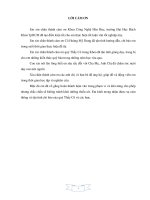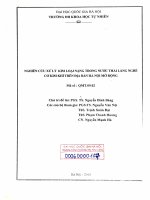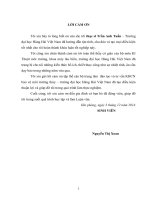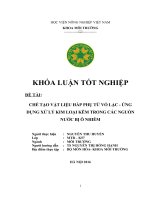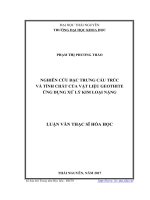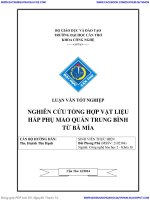Vỏ cam biến tính ứng dụng xử lý kim loại nặng trong nước thải
Bạn đang xem bản rút gọn của tài liệu. Xem và tải ngay bản đầy đủ của tài liệu tại đây (630.03 KB, 17 trang )
See discussions, stats, and author profiles for this publication at: />
Modified Orange Peel as Sorbent in Removing of Heavy Metals from Aqueous
Solution
Article in Journal of Green Engineering · November 2020
CITATION
READS
1
162
3 authors:
Lahieb Faisal Muhaisen
Shahad Al-Najjar
Independent Researcher
Al-Nahrain University
10 PUBLICATIONS 45 CITATIONS
11 PUBLICATIONS 16 CITATIONS
SEE PROFILE
Zainab T. Al-sharify
Al-Mustansiriya University
171 PUBLICATIONS 131 CITATIONS
SEE PROFILE
Some of the authors of this publication are also working on these related projects:
sustainability View project
Using Positron Emission tomography (PET) scan for tumar detection View project
All content following this page was uploaded by Lahieb Faisal Muhaisen on 29 December 2020.
The user has requested enhancement of the downloaded file.
SEE PROFILE
Journal of Green Engineering (JGE)
Volume-10, Issue-11, November 2020
Modified Orange Peel as Sorbent in
Removing of Heavy Metals from Aqueous
Solution
1
M. Lahieb Faisal, 2Shahad Z. Al-Najjar, 3Zainab T. Al-Sharify
1
Department of Environmental Engineering, College of Engineering, University of
Mustansirya, Baghdad, Iraq.
2
Department of Chemical Engineering, College of Engineering, Al-Nahrain
University, Baghdad, Iraq.
3
School of Chemical Engineering, University of Birmingham, Birmingham, United
Kingdom.
E-mail: ,
Abstract
Environmental engineering studies aim is to use low-cost materials mostly
from natural wastes as a Sorbent. Removing heavy metals from simulated
wastewater solutions using chemically modified orange peel named (MOP)
was examined at various pH, adsorbent doses, and temperature on the single
heavy metal solution. Experiments of the batch were executed according to
optimal conditions to estimate the sorption ability MOP. The results present
ahighcapacity of the sorption by MOP of about 91.0 % and 93.44% for Cd
(II) and Ni (II) Consecutively,with the optimum amount of sorbent of MOP
about 3gm and 2.5gm at pH 6; with contact time 180min at 298K
temperature. It was found that the efficiency of sorption of MOP decreased
by increasing the temperature showed the sorption-nature is exothermic.
The mass transfer adequacy in the adsorption process using thesesustainable
low cost modified orange peels make it efficient in removing heavy metals.
The study ofequilibrium isotherm and kinetic models of both ions sorption
by adsorbents were evaluated, the isotherm of Langmuir was assessedto be
the suitable equation for Cd (II) ion removal. In contrast, the suitable model
for Ni (II) removal was Freundlich, and a 2nd kinetic model was utilized to
estimate the kinetic constants of the overall rate of sorption for both
Journal of Green Engineering, Vol. 10_11, 10600-10615.
© 2020 Alpha Publishers. All rights reserved.
10601 M. Lahieb Faisal et al.
ions. MOP showsa high impact in removing ions of cadmium and nickel
from an aqueous solution.
Keywords: Wastewater, Heavy Metals, Fluid Flow, Environmental
Engineering Studies, Cd (II), Ni (II), Mass Transfer, Modified Orange Peel
(MOP), Exothermic.
1 Introduction
Heavy metals is crucial pollutants in the water sources and industrial
water-treatment. Hence,a severepublic health issue is developing every day
byaccumulating the heavy metals'existence. Electroplating, finishing of
metal, and metallurgical are some examples of the leadingcauses of these
heavy metals and the chemical manufacturing, mining, and processes of
battery manufacturing in large quantities. Heavy metals are recognized as
toxic components, and their deposals throughstreams are causingunfavorable
effects on the health of humans alike the environment [1][2][3].
Compoundsof the toxic metal pollute the sources of surface water andother
sources as well [4] [5]. They cause many health disorders and disturbances.
Also, because of their toxicity, the existence of metals in unreasonable
amounts intervenes with the profitable utilize of water [1] [2] [3]. It is also
essential to find a way to get rid of metals in wastewater before dumped into
the atmosphere. Nickel is a pure white alloy, has a radioactive amount of 28.
Drinking water, normally contains Ni of less than ten mg/l, where the typical
day-by-day intake of Ni from water for adults maybe around 7.5 and 15 mg
[6][7][8]. Ni and its components are returned to outstanding hazardous
specialists encountered by additionally proven non-occupationally uncovered
people in the industry [5][7].Cadmium hasa lot of observation by ecologists
as one of the most toxic heavy metals [9] [10] [4] [11][12]. High-quality
water is necessary to a human's life; water with reasonable quality is vital for
domestic, agricultural, commercial, and industrial uses [13]. Many
researchers recently investigate experimentally and numerically using CFD
of the fluid flow of single-phase flow contaminates and multi-phase flow
contaminates [14-19]. From all the above, it was observed that all these
activities are responsible for water pollution. Every day vast quantities of
waste are dumped from these sources into freshwater. The need for water is
increasing as all water resources slowly become unusable because of
inappropriate disposal of waste [20]. The mission of providing suitable
treatment facilitiesfor all sources of contaminationis challenging and costly,
so there is an urgent need for innovative, low-cost technologies that require
low maintenance and energy-efficient. The use of different techniques is
mostly sufficient to remove heavy metals from water and wastewater [21,
22,23]; from these, sorption is efficient and economical. Considered sorption
onto activated carbon is a preferredmethod that has been widely utilized in
Modified Orange Peel as Sorbent in Removing of Heavy Metals from Aqueous
Solution 10602
the past few years. Because The need to achieve economical treatment of
wastewater iscrucial, the researchers intensified their efforts to finding and
developing inexpensive alternatives available from various industrial,
natural, and biological materials or residues [20]. The majority of researchers
used numerous of fruit peel as a substitution of activated carbon due to its
high-priced. The use of agricultural-residues as the sorbent is attracting
attention on a large scale because of the availability of large amounts [24,
25]. Also, a polysaccharide of the top plants' cell wall, Pectin, is
predominantly depending on the acid of galacturonic and contains a
considerable number of groups of carboxyl, with a familiar capability to
contain bi-valence cations. Thus, a material rich in Pectin, like citrus peels
resulting from the Pectin is removed commercially, has a high natural
capability to bind the metal. The Pectin-rich products have been considered
in the potential to bind metal to involve: waste of apple; sugar beet pulp;
peels of orange and banana; citrus peels and husksof coffee, alsomany
kindsof fruit, like various kinds of citrus peel [26-31]. Besides, Natural
Sorbent such as Rice Husk [32], dried olive stone [33], most recently walnuts
Shell as an adsorbent from wastewater contaminated with COVID 19 viruses.
[34]
Orange peel is is normally treated as wastes, although it have a lot of
functional groups, as hydroxyl and carboxyl make it a potential sorbent
material inthe removal of metals [35]. Some researchers suggested in the
literature the ability to utilize the modified waste of orange in rapport with
adsorptionof heavy metal from water [36,37,38]. This work aimed to provide
anadsorbent of modified orange peel (MOP) and assess this sorbent's sorbent
ability in removing two heavy metal ions (Cd2+ and Ni2+).
2 Experimental
2.1 Chemicals
The synthetic solution of cadmium ion and nickel ion provided by
dissolving the Cd (NO3)2.4H2O and N2NiO6.6H2O with distilled water; to
prepare the desired initial concentration was according to Eq.1 [39]:
(1)
Where:
Wt is the heavy metal salt-weight, mg;
V is the volume of the solution, 1liter
Cp is theprimary concentration of metal ions in solution, mg/l;
M.wt is themetal salt molecular weight, g/mole;
At.wt is the metal ion atomic weight of, g/mole.
10603 M. Lahieb Faisal et al.
To adjust the solution's pH to the wanted amount, (0.1M) HCl or (0.1M)
NaOH as needed has been added. Atomic Absorption spectrophotometer has
been used to estimate cadmium and nickel (AAS, GBC 933 plus, Australia).
2.2 Preparation of Modified Orange Peel Adsorbent
Generally, the peels of chemically modified agricultural waste show an
increasingbiosorption capacity than the non-modified types. Several
chemicals have beentested to containorganic acids and minerals, oxidizing
agents, bases, and organic components. In the natural state the
agriculturalpeel or husk has a high content of lignin, hemicelluloses,
cellulose, and mineral ash [40]. The charge ofthissurface of cellulosic will be
partially negativewhen submerging in water, thus producinga Colombian
reaction with the species of cationic in water, Laszlo and Baig [41] checked
on the binding of Cr+2, Ni+2, Pb+2, Cu+2,Zn+2, Cd+2and Cr+2ions to the
deactivated biomass of Solanum Elaeagnifoliumand proposed that the
collectionsofcarboxyl (—COOH) are somewhat in charge of the binding of
ions of metal [42].
Orange Peel (OP) in this paper was gathered from the local market of
juice andwashed with distilled water many times for removingthe dirt; dried
at 100oC for 24 hours in the oven (until steady weight)dueto removing the
content of moisture.This dried peel grinded and sieved to get about 0.6 mm
size of the particles were chosen for this study. Then 10 gm of dried
OPsaturated by a50mL solution ofNaOH (0.1 M) for 6hrs (this
intensifiedpeel treated with sodium hydroxide to enhance sorption capacities
to proposed ions); then using filtration. The orange peel (MOP) changed in
sodium hydroxide had been washed with purified water up to 7.0 pH value;
then washed and placed in airtight vessels for use.
2.3 Adsorption Procedure and Measurement
All adsorption tests were carried out on the batch type.Wastewater
solution of desired concentration (50mg/l) (for each ions) was taken with the
required amount of MOP (1-3.5gm) in 250ml Erlenmeyer flasksto examine
the impact of treated sorbent on the removal of Cd+2and Ni+2a 100ml and
then shaken with fixedagitation speed (200 rpm) at a room temperature
(approximately 25±5°C) for a contact time of 180min. The pH was adjusted
to (3-8). The supernatant was separated by filtration (using filter-paper
Whatman70mm). Initial and final concen.of both ions were specified by the
(AAS). The equation (2) used todetermine the amount of both ions sorbed by
the MOP was as follows [39]:
(2)
Where Cfis thefinal concentration of the metal, mg/l.
Modified Orange Peel as Sorbent in Removing of Heavy Metals from Aqueous
Solution 10604
3 Results and Discussion
3.1 Impact of PH on the Sorption Process
As is customary, thepH is a determining parameterthat governs the
sorption of the metal ions. These ions influence protonsof the functional
groups as well as in the chemistry of metal [43]. Figure1 presents the
removal of Cd+2 and Ni+2 at varying pH ranges from 3 to 8 (with 1 g of the
MOP sorbents used for contact time about 1hr). It evidentfrom the results
(Fig.1a and b) that the removal of studied ions increased significantly with
high pH values. The higher rate of sorption of both ions was noticed at pH
range between 5 to 6, and the efficiency gradually decreasesby increasing pH
values 9(At low values ofpH, metal cations and protons contest for sites of
binding on the surface of sorbent, which contributes to decrease themetal
uptake. It was indicated that the sorbent surface ligands in a quite acidic state
were closely bound to H3O+, which, due to repulsive forces, restricted
access to ligands by metal ions [8, 26 , 44].As pH values rise, it is anticipated
that more ligands would be exposed to negative loads, leading to an
improvement in the appeal of positively charged metal ions. The weaker
association is often due to the metal's lower solubility and precipitation [8,
44-51] while pH is greater. For Cd+2 and Ni+2 ions, the maximum removal at
pH 6 is then acquired with a sequential efficiency of 82 percent and 86
percent.
Figure 1 Impact of PH on the Sorption Process (a: Cd (II); b: Ni (II))
10605 M. Lahieb Faisal et al.
3.2 Impact of MOP Amount on the Sorption Process
The influence of MOP sorbents amounts to one of the generally
influential parameters affecting the capacity of removal and the
capacityofsorption. Figure 2 shows the impact of various quantities of
sorbents (1-3.5 g/100ml) for 2 hours at room temperature. The sorption
efficiency of Cd2+ and Ni2+ increased with increasing the concentrations of
metal ions and quantityof MOP;this behavior is mainly due to the increase in
the surface area of sportive and the availability of more effectivesites of
sorption [19, 29].The maximum removal of Cd+2has been made at more than
2gm of MOP sorbent. The optimum amount was chosen as 3gm with the
removal rate of about 91%, while removing Ni+2was at 2.5gm of MOP
sorbent with the removal of about 91.11%.After more increase in sorbent
weights than 3gm we notice that no effect on the removal rate because the
adsorbent was sufficient to adsorb [44, 45].
Figure 2 Impact of MOP Amount on the Sorption Process (a: Cd (II); b: Ni (II))
3.3 Sorption Isotherm
The modeled adsorption isotherm is calculated utilizing two known
isothermal models i.e., Freundlich and Langmuir, for single soluble Systems.
Adsorption isotherm should be used by characterizing how the solution
reacts with the adsorbent to boost adsorbent use [45].The Langmuir sorption
Modified Orange Peel as Sorbent in Removing of Heavy Metals from Aqueous
Solution 10606
isotherm equation, showed as follows, requires for its applicability singlelayer coverage on the adsorbent surface[39]:
(
)
(3)
Where:
is the biomass sorbed metal ions, mg per each gram,
is the ability of the highest of sorption for monolayer coverage, mg per
each gram,
b is the attraction site constant of binding, mg per liter.
is the metal ions concentration in the solution at balance, mg per liter.
The model of Freundlich is [24]:
(Linear form)
(4)
K = constant refer the relativecapability of adsorption of the adsorbent
(mg/g),
1/n = constant expressing the adsorption potential. K and n presented a range
of adsorption. See Fig.3 (A and B) and Table 1, which shows the above two
models' results.
Figure 3(A) Langmuir Model (a: Cd (II); b: Ni (II))
10607 M. Lahieb Faisal et al.
Figure (3B) Freundlich Model (a: Cd (II); b: Ni (II))
Table 1 The Parameters of Isotherm Models.
Langmuir
coefficients
R2
A
B
Cd (II)
Ni (II)
0.9767
3.3602
0.1794
0.8672
5.7310
0.1895
Freundlich
coefficients
R2
N
K
Cd (II)
Ni (II)
0.8683
2.3912
0.7951
0.9336
1.7819
0.7995
Compared to experiential isotherms, the equation Langmuir was ideal for
eliminating Cd (II) ions with the theoretical isotherm models.In contrast, the
Freundlich model is more adequate to remove Ni (II) ions by using MOP as
sorbents.
3.4 Kinetic Isotherm
The mechanization of dye sorption is described by the kinetics of
adsorption (pseudo-first and second-order).Models describethe adsorption
manner of both ions on MOP. The pseudo-first and-second-order models,
[39]:
(5)
(
)
Modified Orange Peel as Sorbent in Removing of Heavy Metals from Aqueous
Solution 10608
(
)
(6)
The sum of dye adsorbed in balance and qeq(mg/g) and qt (mg/g) in a
corresponding period. For the pseudo-first and second-order models, K1
(min−1) and K2 (g/mg.min) are equal to a constant kinetic volume. The
findings were shown in Table 2.
Table 2 The Factors of Kinetic Models.
Metal
T
aCd
b(II)
l
eNi
(II)
Pseudo-first-order
qeexperimental
2
Pseudo-second-order
qecalculate
k2
R2
k1 1/min
qecalculated
R
1.530
-0.0385
1.0710
0.9203
0.1155
1.580
0.9976
1.956
-0.0386
1.5221
0.8108
0.0998
1.9992
0.9982
d
Table 2 has shown that qe (theoretical)'s results are well-accepted in the
case of the pseudo-second-order constructs with the experiential uptake
measures qe(exp). The correlation(R2) factor was 0.9976 and 0.9982,
respectively for Cd(II) and Ni(II) suggesting that the pseudo-sections phase
for both ions may also be represented.
3.5 Impact of Temperature and Thermodynamic Parameters
It is well established that thermodynamic studies will determine the
physical and chemical adsorption response direction and viability. "These
thermodynamic parameters are normal enthalpy (alternative to H°), standard
free energy (alternative to G°), standard entropy (Alternative to S°)'. From
the following equation, the values of these parameters were obtained [9, 24]:
(
)
(
)
(7)
(8)
ΔG=ΔH-ΔST
In which Kd the distribution coefficient; while ΔH, ΔS,and ΔT the
enthalpy, entropy, and temperatures. R is the gas constants (8,314 J/mol.K)
and Gibbs free energy change ΔG0.
Impact of changing the temperature at 298, 308, 318, and 328K (25,
35,45 and 55Co) "Fig.4", the coefficient values of distribution and the
parameters of thermodynamic arescheduledin Tables 3 and 4, consecutively:
10609 M. Lahieb Faisal et al.
Figure 4 Impact of various temperatures on sorption of both ions by MOP (a: Cd
(II); b: Ni (II))
Table 3 The Coefficients Ofdistribution At Various Temperatures.
Metal
Cd (II)
Ni (II)
R2
kd
298 k
308 k
318 k
328 k
9.438413
13.53488
4.760369
4.181347
3.205214
2.723008
2.132832
1.797985
0.9867
0.9380
Table 4 The Thermal Factors of Cadmium and Nickel Ions Sorption on the MOP
Metal
Cd
(II)
Ni
(II)
∆H(J/mol)
∆G (kJ/mol)
298 k
308 k
318 k
328 k
-39.5954
∆S
(J/mol
K)
114.7581
-284.322
-293.863
-303.404
-53.0633
158.0575
-391.599
-404.74
-417.881
312.945
431.021
Removal of both ions decreased by increasing the process temperature
from 298 to 328 K at pH 6.0 for both Cd and Ni ions, respectively, and at a
Modified Orange Peel as Sorbent in Removing of Heavy Metals from Aqueous
Solution 10610
constant adsorption dose of 3gm and 2.5gm. The decrease inthe adsorption
patternby increasing the temperature valuesdetected that the qualityof
sorption of Cd (II) and Ni (II) ions on MOP is exothermic. Furthermore,
lower values of adsorption distribution parameters (Kd) by increasing
temperature also detect this process's exothermic nature. The increasingcause
to escapethese ions at high temperature could be other caption to this results;
similar results were reported by others [44-46].
4 Conclusions
It was found that orange peel has been modified chemically by sodium
hydroxide improved the removal ofCd (II) and Ni (II) ions from aqueous
solution. Experiential studies suggestedthat the quick removal of both ions
depends mainly on the solution pH; amount of sorbent, andcontact time.
Negative values of (∆G) suggest the thermodynamically practical and
unpromptednatureof Cd (II) and Ni (II) biosorption byMOP. Thus, this
studyprogressesan inexpensive, widely available,and active metalions
sorbents from natural waste as a substitute for present commercial sorbents.
Acknowledgment
The authors would like to thank Mustansiriyah University
(www.uomustansiriyah.edu.iq). for its support in this work and the authors
acknowledge the support of Al-Nahrian University-Iraq and Birmingham
University- UK.
References
[1]. P. Senthil Kumar, K. Krithka. ―Kinetics and Equilibrium Studies of Zn2+
Ions Removal from Aqueous Solutions by Use of Natural Waste‖,
Electronic Journal of Environment, Vol. 9, no. 1, pp. 264- 274, 2010.
[2]. Lahieb Faisal M. ―Batch Sorption of Copper (II) Ions from Simulated
Aqueous Solution by Banana Peel‖, Al-Khwarizmi Engineering Journal,
Vol. 12, no. 4, pp. 117-125, 2016.
[3]. Maryam Q Al-Qaisi, Lahieb Faisal M.A., Zainab T. Al-Sharify., Talib
A. Al-Sharify. ―Possibility of Utilizing from Lemon Peel as a Sorbent in
Removing of Contaminant Such as Copper Ions from Simulated
Aqueous Solution‖, International Journal of Civil Engineering and
Technology (IJCIET) , Vol. 9, no. 11, pp. 571-579, 2018.
[4]. Eman Abed M., Lahieb Faisal M., Younis Swadi T. ―Removal of
Cadmium Ions from Wastewater by Batch Experiments‖, Iraqi Journal of
Chemical and Petroleum Engineering, Vol. 17, no. 3, PP. 101- 108,
2016.
10611 M. Lahieb Faisal et al.
[5]. R. R. Bansode. ―Treatment of organic and inorganic pollutants in
municipal wastewater by agricultural by-product based granular
activated carbons‖, Thesis, The Department of Food Science, Osmania
University, 2002.
[6]. Mukesh Parmar, Lokendra Singh Thakur. ―Adsorption of Heavy Metal
(Cu2+, Ni2+ and Zn2+) from Synthetic Waste Water by Tea Waste
Adsorbent‖, Inter. Jour. of Chem. and Physical Sciences (IJCPS), Vol. 2,
no. 6, pp. 6-19, 2013.
[7]. Yasmin Regina M., Saraswathy S., Kamal B., Karthik V.,
Muthukumaran K. ―Removal of Nickel (II) Ions from Wastewater Using
Low Cost Adsorbents: A Review‖, Journal of Chemical and
Pharmaceutical Sciences, Vol. 8, no. 1, 2015.
[8]. Lahieb Faisal M. ―Nickel Ions Removal from Aqueous Solutions Using
Sawdust as Adsorbent: Equilibrium, Kinetic and Thermodynamic
Studies‖, Journal of Engineering and Sustainable Development , Vol.
21, no. 3, pp. 60-72, 2017.
[9]. B. Volesky, Z.R. Holan. ―Biosorption of Heavy Metals‖, Wiley, Vol. 11,
no.03, pp. 235-250, 1995.
[10].I. Kula, M. Ugurlu, H. Karaoglu, A. Celik. ―Adsorption of Cd(II) ions
from aqueous solutions using activated carbon prepared from olive stone
by ZnCl2 activation‖, Bio resource Technology, Vol. 99, no. 3, pp. 492–
501, 2008.
[11].Al Jaaf, H. J. M., Al-Ubaidy., M. I. B., Al-Sharify. ― Removal of Cd (ll)
from polluted water by filtration using iron oxide coated sand media‖,
IOP Conference Series Materials Science and Engineering , Vol. 870, no.
1, 2020.
[12].M. J. A. Alatabe, Z.T Al-Sharify.― Utilization of low cost adsorbents for
the adsorption process of lead ions‖, International Journal of Modern
Research in Engineering and Technology, Vol .4, no. 11, pp. 29-48,
2019.
[13].D.R. Rzaij, H.J. Al-Jaaf, Al-Najjar, Z.T. Al-Sharify, Al-Moameri,
Mohammed. ―Studying the Concentrations of Nitrite and Nitrate of
Tigris River Water in Baghdad and Their Suitability to the Conditions
Permitted Internationally‖, IOP Conference Series: Materials Science
and Engineering, Vol. 870, no. 1, 2020.
[14].Sadiq S.M., Al-Sharify, H.M Bahiya. ―Simulation of Two-Phase Flow
Contaminates Transport in Pipe Flow under Transient Laminar Flow
Condition‖, Journal of Green Engineering, Vol. 10, no. 6, pp. 3861-3883,
2020.
[15].Muhsun., S. S., Al-Madhhachi., A. S. T., & Al-Sharify, Z. T.
―Prediction and CFD Simulation of the Flow over a Curved Crump Weir
Under Different Longitudinal Slopes‖, International Journal of Civil
Engineering, Vol. 18, pp. 1067–1076, 2020,
Modified Orange Peel as Sorbent in Removing of Heavy Metals from Aqueous
Solution 10612
[16].Hamad, H. T., Al-Sharify, Z. T., Al-Najjar, S. Z., & Gadooa, Z. A., ―A
review on nanotechnology and its applications on Fluid Flow in
agriculture and water recourses‖, IOP Conference Series Materials
Science and Engineering, Vol. 870, 2020.
[17].Muhsun, S. S., Al-Osmy, S. A. T., Al-Hashimi, S. A. M., & Al-Sharify,
Z. T., ―Theoretical, CFD Simulation and Experimental Study to Predict
the Flowrate Across a Square Edge Broad Crested Weir Depending on
the End Depth as a Control Section‖, AWAM International Conference
on Civil Engineering, 2019.
[18].Sadiq, S. M., Gubashi, K. R., Chyad R. F., & Al-Sharify, Z. T.
―Removal of Inorganic Contaminants Using Manufacturing Porous
Media‖, International Academic Journal, Vol. 7, 2018.
[19].Mousa, H. M., Muhsun, S. S., & Al-Sharify, Z. T., ―Two Phase Flow
Experimental Detection Method and CFD models–A review‖, Journal of
Engineering and Sustainable Development, 2020.
[20].Paksamut J., Boonsong P., ― Removal of Copper (II) Ions in Aqueous
Solution Using Tannin-Rich Plants as Natural Bio-Adsorbent‖, IOP
conference series Material Science and Engineering, Vol. 317, no. 1,
2018.
[21].Mohsen J., Fathemeh A., ―Sunflower stalk, an agricultural waste as an
adsorbent for the removal of lead and cadmium from aqueous solutions‖,
Journal of Material Cycles and Waste Management, Vol. 15, pp. 548–
555, 2013.
[22].Esalah JO. Weber ME., Vera JH.,― Removal of lead, cadmium and zinc
from aqueous solutions by precipitation with sodium di-(n-octyl)
phosphinate‖, The Canadian journal of chemical engineering, Vol. 78,no.
5, pp. 948-954, 2000.
[23]. Canet L., Llpide M., Seta P., ―Efficient facilitated transport of lead,
cadmium, zinc and silver across a flat sheet-supported liquid membrane
mediated by lasalocid‖, A. Sep Sci. Technol, Vol. 37, no. 8, pp. 1851–
1860, 2007.
[24].Lahieb F.M. ―Lemon Peel as Natural Biosorbent to Remove Phosphate
from Simulated Wastewater‖, Journal of Engineering and sustainable
Development, Vol. 20, no. 2, pp. 163- 173, 2016.
[25].Bhatnagara A., Minochaa A.K., Mika S., ―Adsorptive removal of cobalt
from aqueous solution by utilizing lemon peel as biosorbent‖,
Biochemical Engineering Journal, Vol. 48, no. 2, pp. 181–186, 2010.
[26].Guo Xue yi, Liang Sha, Tian Qinghua. ―Removal of Heavy Metal Ions
from Aqueous Solutions by Adsorption Using Modified Orange Peel as
Adsorbent‖, Advanced Materials Research, Vol. 236-238, pp. 237-240,
2011.
10613 M. Lahieb Faisal et al.
[27].Lahieb F.M., Farah F.M., Zainab M.A. ―Egg shell as natural sorbent to
remove cadmium ions from simulated wastewate‖, Journal of
Engineering and Sustainable Development, Vol. 23, no. 6, pp. 167-177,
2019.
[28].Zainab Abdul razaq, Salih Rushdi, Gadhban M. Y., Shahad Z. AlNajjar, Al-Sharify, Z. T., ― Possibility of Utilizing the Lemon Peels in
Removing of Red Reactive (RR) Dye from Simulated Aqueous
Solution‖, International Journal of Green Energy, Vol. 10 no. 10, pp.
7343-7359, 2020.
[29].Al-Qaisi, M. Q., Faisal, L., Al-Sharify, Z. T., & Al-Sharify, T. A.,
―Possibility Of Utilizing From Lemon Peel As A Sorbent In Removing
Of Contaminant Such As Copper Ions From Simulated Aqueous
Solution‖, International Journal of Civil Engineering and Technology
(IJCIET), Vol. 9, no. 11, pp. 571-579, 2018.
[30].Gadhban, M. Y., Abdulmajed, Y. R., Ali, F. D., & Al-Sharify, Z. T.,
―Preparation of Nano Zeolite and its Application in Water Treatment‖,
IOP Conference Series Materials Science and Engineering , Vol. 870,
2020.
[31].lahieb, F. M., Al-Sharify, Z. T., & Farah, F. M., ―Role of Rice Husk as
Natural Sorbent in Paracetamol Sorption Equilibrium and Kinetics‖, IOP
Conference Series Materials Science and Engineering, Vol. 870, 2020.
[32].Al-Sharify, Z. T., Faisal, L. M. A., Al-Sharif, T. A., Al-Sharify, N. T., &
Faisal, F. M. A., ―Removal of analgesic paracetamol from wastewater
using dried olive stone‖, Internatinal Journal of Civil Engineering and
Technology, Vol. 9, no. 11, pp. 293-299, 2018.
[33].Rushdi S., Hameed K. K., Jana H & Al-Sharify, Z. T., ―Investigation on
Production of Sustainable Activated Carbon from Walnuts Shell to be
used in Protection from COVID-19 Disease‖, Journal of Green
Engineering, Vol. 10, no. 10, pp. 7517-7526.
[34].Kanamadi R D, Ahalya N, T V Ramachandra "Biosorption of Heavy
Metals by Low Cost Adsorbents", Technical Report. No. 112,2006.
[35].Wan Ngah WS., Hanafiah M., ―Removal of heavy metal ions from
wastewater by chemically plant wastes as adsorbent: A review‖, Biores
Technol, Vol. 99, no. 10, PP. 3935-3948, 2008.
[36].Laszlo JA., Dintzis FR., ―Crop residues as ion-exchange materials:
Treatment of soybean hull and sugar beet fiber (pulp) with
epichlorohydrin to improve cation-exchange capacity and physical
stability‖, Journal of applied polymer science, 1994.
[37].Ahmed A., Lahieb F., ―BatchHeavy MetalsBiosorption by Punica
granatum Peels: Equilibrium and Kinetic Studies‖, Journal of
Engineering, Vol. 21, no. 11, pp. 161-178,2019
[38].Lo, S. F., Wang, S. Y., Tsai, M. J., and Lin, L. D., ―Adsorption capacity
and removal efficiency of heavy metal ions by Moso and Ma bamboo
activated carbons‖, Chemical Engineering Research and Design, Vol. 90,
no. 9, pp. 1397-1406, 2012.
Modified Orange Peel as Sorbent in Removing of Heavy Metals from Aqueous
Solution 10614
[39].Manjeet B., Diwan S., Garg V., Pawan R. ―Use of Agricultural Waste
for the Removal of Nickel Ions from Aqueous Solutions: Equilibrium
and Kinetics Studies‖, International Scholarly and Scientific Research &
Innovation, Vol. 3, no. 3, 2009.
[40].Esposito, A., Pagnanelli, F., Lodi, A., Solisio, C., Veglio, F.,
―Biosorption of Heavy Metals by SphaerotilusNatans, an Equilibrium
Study at Different pH and Biomass Concentration‖, Journal of
Hydrometallurgy, Vol. 60, no. 2, pp. 129-141, 2001.
[41].Moreno-Piraján, J. C., Giraldo, L., ―Heavy metal ions adsorption from
wastewater using activated carbon from orange peel‖, Journal of
Chemistry, Vol. 9, no. 2, 2012.
[42].Moghadam, M. R., Nasirizadeh, N., Dashti, Z., Babanezhad, E.,
―Removal of Fe (II) from aqueous solution using pomegranate peel
carbon: equilibrium and kinetic studies‖, International Journal of
Industrial Chemistry, Vol. 4, 2013.
[43].Aksu, Z., A. Isoglu, ―Removal of Cu (II) ions from aqueous solution by
biosortion onto agricultural waste sugar beet pulp‖, Journal of
Environment Biology, Vol. 40, pp. 3031-3044, 2005.
[44].Feng, N.C., X.Y. Guo S. Liang. ―Kinetic and thermodynamic studies on
biosorption of Cu (II) by chemically Modified Orange Peel‖, Transaction
of Nonferrous Metal Society China, Vol. 19, no. 5, pp. 1365-1370 ,
2009.
[45].Gonen, F., S. Serin. ―Adsorption study on orange peel: Removal of Ni
(II) ions from aqueous solution‖, African Journal of Biotechnology, Vol.
11, no. 5, pp. 1250-1258, 2012.
[46].Arbind K., Vipin K., ―Equilibrium and thermodynamic studies of Cd (II)
biosorption by chemically modified orange peel‖, Journal of
Environmental Biology. Vol. 37, no. 2, pp. 201-206, 2016.
Biographies
Lahieb Faisal M.A. is a lecturer at the Environmental Engineering
Department, college of Engineering, University of Mustansiriyah. She
received her BSc from al Mustansiriyah university, college of Engineering
and MSc from Baghdad university, college of Engineering. Her research
focuses on Environmental pollution
10615 M. Lahieb Faisal et al.
Shahad Z. A. Al-Najjar is a lecturer at the Chemical Engineering
Department, Al-Nahrain University. She received her BSc and MSc from AlNahrian University, Iraq, and PhD degree form the University of
Birmingham, UK. Her research focuses Mass Transfer, Fluid flow, Nano
particles, computational fluid dynamics and formulation technology.
Zainab T. Al-Sharify is a lecturer of chemical engineering at the
Environmental Engineering Department, University of Mustansiriyah. And
she is academic vistior at chemical engineering department, University of
Birmingham, UK.She received her BSc and MSc from Al-Nahrian
University, Iraq, and PhD degree form the University of Birmingham, UK.
She published more than 56 papers in peer reviewed journals. Her research
focuses on Fluid flow, Nano particles, computational fluid dynamics and
formulation technology.
View publication stats


